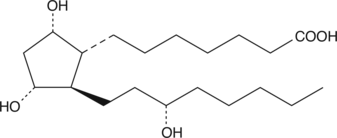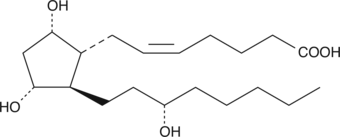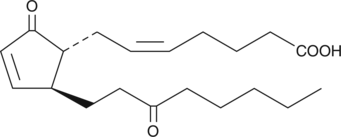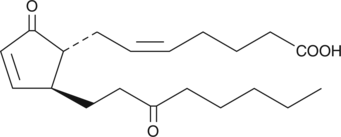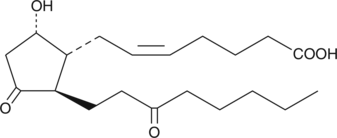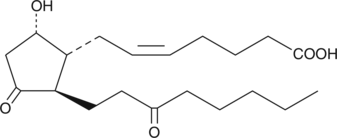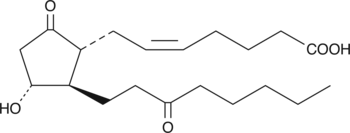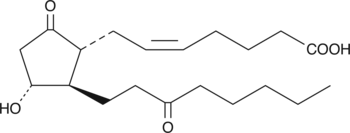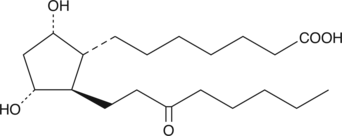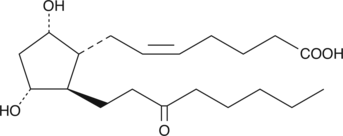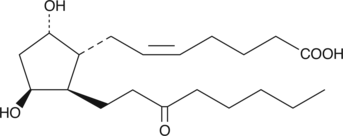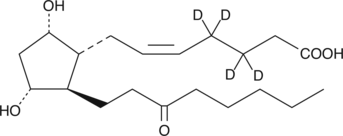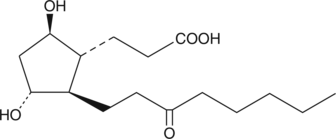Chemicals
Showing 3301–3450 of 41137 results
-
12(Z),15(Z)-Heneicosadienoic acid is an ω-6 very long-chain polyunsaturated fatty acid. It is a positional isomer of heneicosadienoic acid (Item No. 22593) that is rare in living organisms.{39308}
Brand:CaymanSKU:22594 -Out of stock
1233B is a fungal metabolite and an open-ring derivative of L-659,699 (hymeglusin; Item No. 11899) that lacks HMG-CoA synthase inhibitory activity.{49098,21712}
Brand:CaymanSKU:27712 - 1 mgAvailable on backorder
1233B is a fungal metabolite and an open-ring derivative of L-659,699 (hymeglusin; Item No. 11899) that lacks HMG-CoA synthase inhibitory activity.{49098,21712}
Brand:CaymanSKU:27712 - 500 µgAvailable on backorder
13-acetyl-9-Dihydrobaccatin III is a taxane originally isolated from T. canadensis.{54042} It inhibits proliferation of P388 leukemia cells with an IC50 value of 20 μg/ml.
Brand:CaymanSKU:29701 - 1 mgAvailable on backorder
13-acetyl-9-Dihydrobaccatin III is a taxane originally isolated from T. canadensis.{54042} It inhibits proliferation of P388 leukemia cells with an IC50 value of 20 μg/ml.
Brand:CaymanSKU:29701 - 10 mgAvailable on backorder
13-acetyl-9-Dihydrobaccatin III is a taxane originally isolated from T. canadensis.{54042} It inhibits proliferation of P388 leukemia cells with an IC50 value of 20 μg/ml.
Brand:CaymanSKU:29701 - 5 mgAvailable on backorder
13-cis Retinoic acid-d5 is intended for use as an internal standard for the quantification of 13-cis retinoic acid by GC- or LC-MS. 13-cis Retinoic acid is a naturally occurring retinoid that inhibits retinol oxidation and dehydrogenation of 17β-hydroxy steroids.{40199}
Brand:CaymanSKU:21855 -Out of stock
13-Docosenamide is the amide of docosenoic acid. It was first identified in the cerebrospinal fluid of sleep-deprived cats. It has also been detected in the cerebrospinal fluid of rats and humans.{1317} 13-Docosenamide causes reduced mobility and slightly lessened awareness in rats, whereas 9-octadecenamide induces physiological sleep.
Brand:CaymanSKU:90377 - 1 gAvailable on backorder
13-Docosenamide is the amide of docosenoic acid. It was first identified in the cerebrospinal fluid of sleep-deprived cats. It has also been detected in the cerebrospinal fluid of rats and humans.{1317} 13-Docosenamide causes reduced mobility and slightly lessened awareness in rats, whereas 9-octadecenamide induces physiological sleep.
Brand:CaymanSKU:90377 - 5 gAvailable on backorder
13-epi-12-oxo Phytodienoic acid (13-epi-12-oxo PDA) is a lipoxygenase metabolite of α-linolenic acid in the leaves of green plants such as corn. ω-3 and ω-6 polyunsaturated fatty acids in plants are substrates for plant lipoxygenases.{857} 12-oxo PDA is one of the best studied end metabolites of this enzymatic pathway.{1562} While the initial enzymatic product and major isomer of 12-oxo PDA contains side chains in the cis position, both being β to the ring, the upper side chain attached at C-13, can and frequently does, isomerize when 12-oxo PDA is extracted, isolated, or stored. 13-epi-12-oxo PDA is the product of this isomerization.
Brand:CaymanSKU:10195 - 1 mgAvailable on backorder
13-epi-12-oxo Phytodienoic acid (13-epi-12-oxo PDA) is a lipoxygenase metabolite of α-linolenic acid in the leaves of green plants such as corn. ω-3 and ω-6 polyunsaturated fatty acids in plants are substrates for plant lipoxygenases.{857} 12-oxo PDA is one of the best studied end metabolites of this enzymatic pathway.{1562} While the initial enzymatic product and major isomer of 12-oxo PDA contains side chains in the cis position, both being β to the ring, the upper side chain attached at C-13, can and frequently does, isomerize when 12-oxo PDA is extracted, isolated, or stored. 13-epi-12-oxo PDA is the product of this isomerization.
Brand:CaymanSKU:10195 - 100 µgAvailable on backorder
13-epi-12-oxo Phytodienoic acid (13-epi-12-oxo PDA) is a lipoxygenase metabolite of α-linolenic acid in the leaves of green plants such as corn. ω-3 and ω-6 polyunsaturated fatty acids in plants are substrates for plant lipoxygenases.{857} 12-oxo PDA is one of the best studied end metabolites of this enzymatic pathway.{1562} While the initial enzymatic product and major isomer of 12-oxo PDA contains side chains in the cis position, both being β to the ring, the upper side chain attached at C-13, can and frequently does, isomerize when 12-oxo PDA is extracted, isolated, or stored. 13-epi-12-oxo PDA is the product of this isomerization.
Brand:CaymanSKU:10195 - 500 µgAvailable on backorder
13-methyl Myristic acid is a methylated fatty acid that has been found in dairy ewe rumen liquor, bovine milk, goat milk fat, the edible flesh of rainbow trout (O. mykiss), and Flavobacterium.{39687,39688,39689,39690,39691} 13-methyl Myristic acid is also found in arable soil, and its levels decrease in response to contamination with the heavy metals cadmium, copper, nickel, and lead.{39692} [Matreya, LLC. Catalog No. 1605]
Brand:CaymanSKU:24811 - 10 mgAvailable on backorder
13-methyl Myristic acid is a methylated fatty acid that has been found in dairy ewe rumen liquor, bovine milk, goat milk fat, the edible flesh of rainbow trout (O. mykiss), and Flavobacterium.{39687,39688,39689,39690,39691} 13-methyl Myristic acid is also found in arable soil, and its levels decrease in response to contamination with the heavy metals cadmium, copper, nickel, and lead.{39692} [Matreya, LLC. Catalog No. 1605]
Brand:CaymanSKU:24811 - 25 mgAvailable on backorder
13-methyl Myristic acid is a methylated fatty acid that has been found in dairy ewe rumen liquor, bovine milk, goat milk fat, the edible flesh of rainbow trout (O. mykiss), and Flavobacterium.{39687,39688,39689,39690,39691} 13-methyl Myristic acid is also found in arable soil, and its levels decrease in response to contamination with the heavy metals cadmium, copper, nickel, and lead.{39692} [Matreya, LLC. Catalog No. 1605]
Brand:CaymanSKU:24811 - 5 mgAvailable on backorder
13-methyl Myristic acid methyl ester is a methylated bacterial fatty acid methyl ester.{39693,39694} It has been used as a marker of bacteria in sewage sludges and of bacterial contaminants in pharmaceutical manufacturing by GC-MS.{39695,39696} [Matreya, LLC. Catalog No. 1600]
Brand:CaymanSKU:24812 - 10 mgAvailable on backorder
13-methyl Myristic acid methyl ester is a methylated bacterial fatty acid methyl ester.{39693,39694} It has been used as a marker of bacteria in sewage sludges and of bacterial contaminants in pharmaceutical manufacturing by GC-MS.{39695,39696} [Matreya, LLC. Catalog No. 1600]
Brand:CaymanSKU:24812 - 25 mgAvailable on backorder
13-methyl Pentadecanoic acid methyl ester is a methylated fatty acid methyl ester that has been found in the bioactive fraction of A. malabarica extract, C. variabilis microalgae, and baboon liver.{39697,40927,39698} [Matreya, LLC. Catalog No. 1613]
Brand:CaymanSKU:24819 - 10 mgAvailable on backorder
13-methyl Pentadecanoic acid methyl ester is a methylated fatty acid methyl ester that has been found in the bioactive fraction of A. malabarica extract, C. variabilis microalgae, and baboon liver.{39697,40927,39698} [Matreya, LLC. Catalog No. 1613]
Brand:CaymanSKU:24819 - 25 mgAvailable on backorder
13-methyl Pentadecanoic acid methyl ester is a methylated fatty acid methyl ester that has been found in the bioactive fraction of A. malabarica extract, C. variabilis microalgae, and baboon liver.{39697,40927,39698} [Matreya, LLC. Catalog No. 1613]
Brand:CaymanSKU:24819 - 5 mgAvailable on backorder
13-Methylberberine (13-MB) (chloride) is a 13-methyl-substituted derivative of berberine (Item No. 10006427). Berberine is a widely distributed berberidaceaen alkaloid found in plant tissues that has antibacterial, anti-inflammatory, antitumor, anti-obesity, and hypercholesterolemic activity.{32930,12390} 13-MB has improved antibacterial activity against S. aureus (MIC = 125 µg/ml) and improved antitumor activity with a mean GI50 value of 11.7 µM, as compared to berberine.{37022,37023,37024} 13-MB also induces down-regulation of adipocyte differentiation transcription factors, reduces de novo lipid synthesis, and accumulates in murine 3T3-L1 adipocytes at higher levels than berberine, suggesting improved anti-obesity activity.{32930}
Brand:CaymanSKU:21154 -Out of stock
13-Methylberberine (13-MB) (chloride) is a 13-methyl-substituted derivative of berberine (Item No. 10006427). Berberine is a widely distributed berberidaceaen alkaloid found in plant tissues that has antibacterial, anti-inflammatory, antitumor, anti-obesity, and hypercholesterolemic activity.{32930,12390} 13-MB has improved antibacterial activity against S. aureus (MIC = 125 µg/ml) and improved antitumor activity with a mean GI50 value of 11.7 µM, as compared to berberine.{37022,37023,37024} 13-MB also induces down-regulation of adipocyte differentiation transcription factors, reduces de novo lipid synthesis, and accumulates in murine 3T3-L1 adipocytes at higher levels than berberine, suggesting improved anti-obesity activity.{32930}
Brand:CaymanSKU:21154 -Out of stock
13-Methylberberine (13-MB) (chloride) is a 13-methyl-substituted derivative of berberine (Item No. 10006427). Berberine is a widely distributed berberidaceaen alkaloid found in plant tissues that has antibacterial, anti-inflammatory, antitumor, anti-obesity, and hypercholesterolemic activity.{32930,12390} 13-MB has improved antibacterial activity against S. aureus (MIC = 125 µg/ml) and improved antitumor activity with a mean GI50 value of 11.7 µM, as compared to berberine.{37022,37023,37024} 13-MB also induces down-regulation of adipocyte differentiation transcription factors, reduces de novo lipid synthesis, and accumulates in murine 3T3-L1 adipocytes at higher levels than berberine, suggesting improved anti-obesity activity.{32930}
Brand:CaymanSKU:21154 -Out of stock
13-oxoODE is produced from 13-HODE by a NAD+-dependent dehydrogenase present in rat colonic mucosa.{184} 13-OxoODE stimulates cell proliferation when instilled intrarectally in rats.{2210} 13-OxoODE has also been detected in preparations of rabbit reticulocyte plasma and mitochondrial membranes, mostly esterified to phospholipids. Production of 13-oxoODE is putatively linked to the maturation of reticulocytes to erythrocytes through the activity of 15-LO.{2261,2262}
Brand:CaymanSKU:38620 - 100 µgAvailable on backorder
13-oxoODE is produced from 13-HODE by a NAD+-dependent dehydrogenase present in rat colonic mucosa.{184} 13-OxoODE stimulates cell proliferation when instilled intrarectally in rats.{2210} 13-OxoODE has also been detected in preparations of rabbit reticulocyte plasma and mitochondrial membranes, mostly esterified to phospholipids. Production of 13-oxoODE is putatively linked to the maturation of reticulocytes to erythrocytes through the activity of 15-LO.{2261,2262}
Brand:CaymanSKU:38620 - 25 µgAvailable on backorder
13-oxoODE is produced from 13-HODE by a NAD+-dependent dehydrogenase present in rat colonic mucosa.{184} 13-OxoODE stimulates cell proliferation when instilled intrarectally in rats.{2210} 13-OxoODE has also been detected in preparations of rabbit reticulocyte plasma and mitochondrial membranes, mostly esterified to phospholipids. Production of 13-oxoODE is putatively linked to the maturation of reticulocytes to erythrocytes through the activity of 15-LO.{2261,2262}
Brand:CaymanSKU:38620 - 50 µgAvailable on backorder
13,14-dehydro-15-cyclohexyl Carbaprostacyclin is a chemically stable analog of PGI2. It inhibits the ADP-induced aggregation of human platelets with an ED50 of about 40 nM in PRP and 77 nM in washed platelets, which is comparable to the potency of carbaprostacyclin.{1272,1283}
Brand:CaymanSKU:-Available on backorder
13,14-dehydro-15-cyclohexyl Carbaprostacyclin is a chemically stable analog of PGI2. It inhibits the ADP-induced aggregation of human platelets with an ED50 of about 40 nM in PRP and 77 nM in washed platelets, which is comparable to the potency of carbaprostacyclin.{1272,1283}
Brand:CaymanSKU:-Available on backorder
13,14-dehydro-15-cyclohexyl Carbaprostacyclin is a chemically stable analog of PGI2. It inhibits the ADP-induced aggregation of human platelets with an ED50 of about 40 nM in PRP and 77 nM in washed platelets, which is comparable to the potency of carbaprostacyclin.{1272,1283}
Brand:CaymanSKU:-Available on backorder
13,14-dihydro Prostaglandin E1 (13,14-dihydro PGE1) is a biologically active metabolite of PGE1 with comparable potency to the parent compound.{4168,182} It is an inhibitor of ADP-induced platelet aggregation in human PRP and washed platelets with IC50 values of 31 and 21 nM, respectively.{1607} 13,14-dihydro PGE1 is a slightly more potent inhibitor of ADP-induced human platelet aggregation than PGE1 (Item No. 13010) which has an IC50 value of 40 nM.{960} Also, 13,14-dihydro PGE1 was shown to activate adenylate cyclase in NCB-20 hybrid cells with a Kact value of 668 nM.{1926}
Brand:CaymanSKU:-13,14-dihydro Prostaglandin E1 (13,14-dihydro PGE1) is a biologically active metabolite of PGE1 with comparable potency to the parent compound.{4168,182} It is an inhibitor of ADP-induced platelet aggregation in human PRP and washed platelets with IC50 values of 31 and 21 nM, respectively.{1607} 13,14-dihydro PGE1 is a slightly more potent inhibitor of ADP-induced human platelet aggregation than PGE1 (Item No. 13010) which has an IC50 value of 40 nM.{960} Also, 13,14-dihydro PGE1 was shown to activate adenylate cyclase in NCB-20 hybrid cells with a Kact value of 668 nM.{1926}
Brand:CaymanSKU:-13,14-dihydro Prostaglandin E1 (13,14-dihydro PGE1) is a biologically active metabolite of PGE1 with comparable potency to the parent compound.{4168,182} It is an inhibitor of ADP-induced platelet aggregation in human PRP and washed platelets with IC50 values of 31 and 21 nM, respectively.{1607} 13,14-dihydro PGE1 is a slightly more potent inhibitor of ADP-induced human platelet aggregation than PGE1 (Item No. 13010) which has an IC50 value of 40 nM.{960} Also, 13,14-dihydro PGE1 was shown to activate adenylate cyclase in NCB-20 hybrid cells with a Kact value of 668 nM.{1926}
Brand:CaymanSKU:-13,14-dihydro Prostaglandin E1 (13,14-dihydro PGE1) is a biologically active metabolite of PGE1 with comparable potency to the parent compound.{4168,182} It is an inhibitor of ADP-induced platelet aggregation in human PRP and washed platelets with IC50 values of 31 and 21 nM, respectively.{1607} 13,14-dihydro PGE1 is a slightly more potent inhibitor of ADP-induced human platelet aggregation than PGE1 (Item No. 13010) which has an IC50 value of 40 nM.{960} Also, 13,14-dihydro PGE1 was shown to activate adenylate cyclase in NCB-20 hybrid cells with a Kact value of 668 nM.{1926}
Brand:CaymanSKU:-13,14-dihydro PGF1α is a potential metabolite of PGF1α.{2346} Its biological activity has not been reported. The corresponding compound in the E1 series (13,14-dihydro PGE1) retains biological activity similar to PGE1.{4168}
Brand:CaymanSKU:-13,14-dihydro PGF1α is a potential metabolite of PGF1α.{2346} Its biological activity has not been reported. The corresponding compound in the E1 series (13,14-dihydro PGE1) retains biological activity similar to PGE1.{4168}
Brand:CaymanSKU:-13,14-dihydro PGF1α is a potential metabolite of PGF1α.{2346} Its biological activity has not been reported. The corresponding compound in the E1 series (13,14-dihydro PGE1) retains biological activity similar to PGE1.{4168}
Brand:CaymanSKU:-13,14-dihydro Prostaglandin F2α (13,14-dihydro PGF2α) is the analog of PGF2α which has no unsaturation in the lower side chain. It causes luteolysis in hamsters with a potency five times higher than PGF2α. The ED50 value for 13,14-dihydro PGF2α as a luteolytic agent in hamsters is 1.5 µg/100 g.{1795}
Brand:CaymanSKU:-Out of stock
13,14-dihydro Prostaglandin F2α (13,14-dihydro PGF2α) is the analog of PGF2α which has no unsaturation in the lower side chain. It causes luteolysis in hamsters with a potency five times higher than PGF2α. The ED50 value for 13,14-dihydro PGF2α as a luteolytic agent in hamsters is 1.5 µg/100 g.{1795}
Brand:CaymanSKU:-Out of stock
13,14-dihydro Prostaglandin F2α (13,14-dihydro PGF2α) is the analog of PGF2α which has no unsaturation in the lower side chain. It causes luteolysis in hamsters with a potency five times higher than PGF2α. The ED50 value for 13,14-dihydro PGF2α as a luteolytic agent in hamsters is 1.5 µg/100 g.{1795}
Brand:CaymanSKU:-Out of stock
PGE2 is metabolized rapidly to 13,14-dihydro-15-keto PGE2, which is present in the plasma of humans and other mammals. 13,14-dihydro-15-keto PGA2 results from the non-enzymatic dehydration of 13,14-dihydro-15-keto PGE2, a process which is accelerated by the presence of albumin.{581,366} Further decomposition of 13,14-dihydro-15-keto PGA2 by the intentional addition of base produces bicyclo PGE2, a stable marker of PGE2 biosynthesis.{366}
Brand:CaymanSKU:10260 - 1 mgAvailable on backorder
PGE2 is metabolized rapidly to 13,14-dihydro-15-keto PGE2, which is present in the plasma of humans and other mammals. 13,14-dihydro-15-keto PGA2 results from the non-enzymatic dehydration of 13,14-dihydro-15-keto PGE2, a process which is accelerated by the presence of albumin.{581,366} Further decomposition of 13,14-dihydro-15-keto PGA2 by the intentional addition of base produces bicyclo PGE2, a stable marker of PGE2 biosynthesis.{366}
Brand:CaymanSKU:10260 - 10 mgAvailable on backorder
PGE2 is metabolized rapidly to 13,14-dihydro-15-keto PGE2, which is present in the plasma of humans and other mammals. 13,14-dihydro-15-keto PGA2 results from the non-enzymatic dehydration of 13,14-dihydro-15-keto PGE2, a process which is accelerated by the presence of albumin.{581,366} Further decomposition of 13,14-dihydro-15-keto PGA2 by the intentional addition of base produces bicyclo PGE2, a stable marker of PGE2 biosynthesis.{366}
Brand:CaymanSKU:10260 - 5 mgAvailable on backorder
Prostaglandin E2 (PGE2; Item Nos. 14010 | 10007211) is metabolized rapidly to 13,14-dihydro-15-keto PGE2 (Item Nos. 14650 | 10007214), which is present in the plasma of humans and other mammals. 13,14-dihydro-15-keto PGA2 results from the non-enzymatic dehydration of 13,14-dihydro-15-keto PGE2, a process which is accelerated by the presence of albumin.{581,366} Further decomposition of 13,14-dihydro-15-keto PGA2 by the intentional addition of base produces bicyclo PGE2 (Item No. 14530), a stable marker of PGE2 biosynthesis.{366} 13,14-dihydro-15-keto PGA2 MaxSpec® standard is a quantitative grade standard of 13,14-dihydro-15-keto PGA2 (Item No. 10260) that has been prepared specifically for mass spectrometry or any application where quantitative reproducibility is required. The solution has been prepared gravimetrically and is supplied in a deactivated glass ampule sealed under argon. The concentration was verified by comparison to an independently prepared calibration standard. This 13,14-dihydro-15-keto PGA2 MaxSpec® standard is guaranteed to meet identity, purity, stability, and concentration specifications and is provided with a batchspecific certificate of analysis. Ongoing stability testing is performed to ensure the concentration remains accurate throughout the shelf life of the product. Note: The amount of solution added to the vial is in excess of the listed amount. Therefore, it is necessary to accurately measure volumes for preparation of calibration standards. Follow recommended storage and handling conditions to maintain product quality.
Brand:CaymanSKU:10007200 - 100 µgAvailable on backorder
Prostaglandin D1 (PGD1) is the theoretical D-series metabolite of dihomo-γ-linolenic acid (DGLA), but to date it has not been isolated as a natural product. It is an inhibitor of ADP-induced platelet aggregation in humans with an IC50 value of 320 ng/ml, about 1/10 as potent as PGD2.{1139} 13,14-dihydro-15-keto Prostaglandin D1 (13,14-dihydro-15-keto PGD1) is the theoretical metabolite of PGD1 via the 15-hydroxy PG dehydrogenase metabolic pathway. No biological studies for this compound have been reported.
Brand:CaymanSKU:10010425 - 1 mgAvailable on backorder
Prostaglandin D1 (PGD1) is the theoretical D-series metabolite of dihomo-γ-linolenic acid (DGLA), but to date it has not been isolated as a natural product. It is an inhibitor of ADP-induced platelet aggregation in humans with an IC50 value of 320 ng/ml, about 1/10 as potent as PGD2.{1139} 13,14-dihydro-15-keto Prostaglandin D1 (13,14-dihydro-15-keto PGD1) is the theoretical metabolite of PGD1 via the 15-hydroxy PG dehydrogenase metabolic pathway. No biological studies for this compound have been reported.
Brand:CaymanSKU:10010425 - 10 mgAvailable on backorder
Prostaglandin D1 (PGD1) is the theoretical D-series metabolite of dihomo-γ-linolenic acid (DGLA), but to date it has not been isolated as a natural product. It is an inhibitor of ADP-induced platelet aggregation in humans with an IC50 value of 320 ng/ml, about 1/10 as potent as PGD2.{1139} 13,14-dihydro-15-keto Prostaglandin D1 (13,14-dihydro-15-keto PGD1) is the theoretical metabolite of PGD1 via the 15-hydroxy PG dehydrogenase metabolic pathway. No biological studies for this compound have been reported.
Brand:CaymanSKU:10010425 - 5 mgAvailable on backorder
13,14-dihydro-15-keto Prostaglandin D2 (13,14-dihydro-15-keto PGD2) is a metabolite of PGD2 (Item No. 12010) which is formed through the 15-hydroxy PGDH pathway. 13,14-dihydro-15-keto PGD2 was recently identified as a selective agonist for the CRTH2/DP2 receptor.{5248} It also inhibits ion flux in a canine colonic mucosa preparation.{9769} In humans, 13,14-dihydro-15-keto PGD2 is further metabolized to give 11β-hydroxy compounds which have also undergone β-oxidation of one or both side chains. Virtually no 13,14-dihydro-15-keto PGD2 survives intact in the urine.{418,35}
Brand:CaymanSKU:12610 - 1 mgAvailable on backorder
13,14-dihydro-15-keto Prostaglandin D2 (13,14-dihydro-15-keto PGD2) is a metabolite of PGD2 (Item No. 12010) which is formed through the 15-hydroxy PGDH pathway. 13,14-dihydro-15-keto PGD2 was recently identified as a selective agonist for the CRTH2/DP2 receptor.{5248} It also inhibits ion flux in a canine colonic mucosa preparation.{9769} In humans, 13,14-dihydro-15-keto PGD2 is further metabolized to give 11β-hydroxy compounds which have also undergone β-oxidation of one or both side chains. Virtually no 13,14-dihydro-15-keto PGD2 survives intact in the urine.{418,35}
Brand:CaymanSKU:12610 - 10 mgAvailable on backorder
13,14-dihydro-15-keto Prostaglandin D2 (13,14-dihydro-15-keto PGD2) is a metabolite of PGD2 (Item No. 12010) which is formed through the 15-hydroxy PGDH pathway. 13,14-dihydro-15-keto PGD2 was recently identified as a selective agonist for the CRTH2/DP2 receptor.{5248} It also inhibits ion flux in a canine colonic mucosa preparation.{9769} In humans, 13,14-dihydro-15-keto PGD2 is further metabolized to give 11β-hydroxy compounds which have also undergone β-oxidation of one or both side chains. Virtually no 13,14-dihydro-15-keto PGD2 survives intact in the urine.{418,35}
Brand:CaymanSKU:12610 - 5 mgAvailable on backorder
13,14-dihydro-15-keto Prostaglandin D2 (13,14-dihydro-15-keto PGD2) is a metabolite of PGD2 (Item Nos. 12010 | 10007202) which is formed through the 15-hydroxy PGDH pathway. 13,14-dihydro-15-keto PGD2 was recently identified as a selective agonist for the CRTH2/DP2 receptor.{5248} It also inhibits ion flux in a canine colonic mucosa preparation.{9769} In humans, 13,14-dihydro-15-keto PGD2 is further metabolized to give 11β-hydroxy compounds which have also undergone β-oxidation of one or both side chains. Virtually no 13,14-dihydro-15-keto PGD2 survives intact in the urine.{418,35} 13,14-dihydro-15-keto PGD2 MaxSpec® standard is a quantitative grade standard of 13,14-dihydro-15-keto PGD2 (Item No. 12610) that has been prepared specifically for mass spectrometry or any application where quantitative reproducibility is required. The solution has been prepared gravimetrically and is supplied in a deactivated glass ampule sealed under argon. The concentration was verified by comparison to an independently prepared calibration standard. This 13,14-dihydro-15-keto PGD2 MaxSpec® standard is guaranteed to meet identity, purity, stability, and concentration specifications and is provided with a batch-specific certificate of analysis. Ongoing stability testing is performed to ensure the concentration remains accurate throughout the shelf life of the product. Note: The amount of solution added to the vial is in excess of the listed amount. Therefore, it is necessary to accurately measure volumes for preparation of calibration standards. Follow recommended storage and handling conditions to maintain product quality.
Brand:CaymanSKU:10007208 - 100 µgAvailable on backorder
13,14-dihydro-15-keto Prostaglandin E1 (PGE1) is a metabolite of PGE1 with much reduced biological activity.{4383,182,2126} Steady state plasma concentrations are about 10 pg/ml.{4383} 13,14-dihydro-15-keto PGE1 is a weak inhibitor of ADP-induced platelet aggregation in human PRP and washed platelets with IC50 values of 54 and 200 µM, respectively, compared to PGE1 which has an IC50 of 40 nM.{960}
Brand:CaymanSKU:-13,14-dihydro-15-keto Prostaglandin E1 (PGE1) is a metabolite of PGE1 with much reduced biological activity.{4383,182,2126} Steady state plasma concentrations are about 10 pg/ml.{4383} 13,14-dihydro-15-keto PGE1 is a weak inhibitor of ADP-induced platelet aggregation in human PRP and washed platelets with IC50 values of 54 and 200 µM, respectively, compared to PGE1 which has an IC50 of 40 nM.{960}
Brand:CaymanSKU:-13,14-dihydro-15-keto Prostaglandin E1 (PGE1) is a metabolite of PGE1 with much reduced biological activity.{4383,182,2126} Steady state plasma concentrations are about 10 pg/ml.{4383} 13,14-dihydro-15-keto PGE1 is a weak inhibitor of ADP-induced platelet aggregation in human PRP and washed platelets with IC50 values of 54 and 200 µM, respectively, compared to PGE1 which has an IC50 of 40 nM.{960}
Brand:CaymanSKU:-13,14-dihydro-15-keto Prostaglandin E2 (13,14-dihydro-15-keto PGE2) is the primary metabolite of PGE2 (Item No. 14010) in plasma.{182} Endogenous or infused PGE2 is rapidly metabolized by the enzymes 15-hydroxy PGDH and 15-oxo-PG Δ13-reductase to form 13,14-dihydro-15-keto PGE2. 13,14-dihydro-15-keto PGE2 accumulates to detectable levels; plasma levels in humans are between 10-100 pg/ml.{366,433} It undergoes further metabolism and chemical decomposition, giving it a relatively short half-life. In dogs, the plasma half-life of 13,14-dihydro-15-keto PGE2 is about 9 minutes.{433} In humans the metabolite has a similar short half-life, making it a poor choice of analytes for assays designed to measure total PGE2 biosynthesis.{4383,581}
Brand:CaymanSKU:-13,14-dihydro-15-keto Prostaglandin E2 (13,14-dihydro-15-keto PGE2) is the primary metabolite of PGE2 (Item No. 14010) in plasma.{182} Endogenous or infused PGE2 is rapidly metabolized by the enzymes 15-hydroxy PGDH and 15-oxo-PG Δ13-reductase to form 13,14-dihydro-15-keto PGE2. 13,14-dihydro-15-keto PGE2 accumulates to detectable levels; plasma levels in humans are between 10-100 pg/ml.{366,433} It undergoes further metabolism and chemical decomposition, giving it a relatively short half-life. In dogs, the plasma half-life of 13,14-dihydro-15-keto PGE2 is about 9 minutes.{433} In humans the metabolite has a similar short half-life, making it a poor choice of analytes for assays designed to measure total PGE2 biosynthesis.{4383,581}
Brand:CaymanSKU:-13,14-dihydro-15-keto Prostaglandin E2 (13,14-dihydro-15-keto PGE2) is the primary metabolite of PGE2 (Item No. 14010) in plasma.{182} Endogenous or infused PGE2 is rapidly metabolized by the enzymes 15-hydroxy PGDH and 15-oxo-PG Δ13-reductase to form 13,14-dihydro-15-keto PGE2. 13,14-dihydro-15-keto PGE2 accumulates to detectable levels; plasma levels in humans are between 10-100 pg/ml.{366,433} It undergoes further metabolism and chemical decomposition, giving it a relatively short half-life. In dogs, the plasma half-life of 13,14-dihydro-15-keto PGE2 is about 9 minutes.{433} In humans the metabolite has a similar short half-life, making it a poor choice of analytes for assays designed to measure total PGE2 biosynthesis.{4383,581}
Brand:CaymanSKU:-13,14-dihydro-15-keto Prostaglandin E2 (13,14-dihydro-15-keto PGE2) is the primary metabolite of PGE2 (Item Nos. 14010 | 10007211) in plasma.{182} Endogenous or infused PGE2 is rapidly metabolized by the enzymes 15-hydroxy PGDH and 15-oxo-prostaglandin Δ13-reductase to form 13,14-dihydro-15-keto PGE2. 13,14-dihydro-15-keto PGE2 accumulates to detectable levels; plasma levels in humans are between 10-100 pg/ml.{433,4383} It undergoes further metabolism and chemical decomposition, giving it a relatively short half-life. In dogs, the plasma half-life of 13,14-dihydro-15-keto PGE2 is about 9 minutes.{433} In humans the metabolite has a similar short half-life, making it a poor choice of analytes for assays designed to measure total PGE2 biosynthesis.{366,581} 13,14-dihydro-15-keto PGE2 MaxSpec® standard is a quantitative grade standard of 13,14-dihydro-15-keto PGE2 (Item No. 14650) that has been prepared specifically for mass spectrometry or any application where quantitative reproducibility is required. The solution has been prepared gravimetrically and is supplied in a deactivated glass ampule sealed under argon. The concentration was verified by comparison to an independently prepared calibration standard. This 13,14-dihydro-15-keto PGE2 MaxSpec® standard is guaranteed to meet identity, purity, stability, and concentration specifications and is provided with a batchspecific certificate of analysis. Ongoing stability testing is performed to ensure the concentration remains accurate throughout the shelf life of the product. Note: The amount of solution added to the vial is in excess of the listed amount. Therefore, it is necessary to accurately measure volumes for preparation of calibration standards. Follow recommended storage and handling conditions to maintain product quality.
Brand:CaymanSKU:10007214 - 100 µgAvailable on backorder
13,14-dihydro-15-keto Prostaglandin F1α (13,14-dihydro-15-keto PGF1α) is a metabolite of PGF1α that has been reported in the rat stomach.{1164} The measurement of 13,14-dihydro-15-keto PGF1α can be used as a marker of the in vivo production of PGF1α.{2106}
Brand:CaymanSKU:-13,14-dihydro-15-keto Prostaglandin F1α (13,14-dihydro-15-keto PGF1α) is a metabolite of PGF1α that has been reported in the rat stomach.{1164} The measurement of 13,14-dihydro-15-keto PGF1α can be used as a marker of the in vivo production of PGF1α.{2106}
Brand:CaymanSKU:-13,14-dihydro-15-keto Prostaglandin F1α (13,14-dihydro-15-keto PGF1α) is a metabolite of PGF1α that has been reported in the rat stomach.{1164} The measurement of 13,14-dihydro-15-keto PGF1α can be used as a marker of the in vivo production of PGF1α.{2106}
Brand:CaymanSKU:-13,14-dihydro-15-keto Prostaglandin F1α (13,14-dihydro-15-keto PGF1α) is a metabolite of PGF1α that has been reported in the rat stomach.{1164} The measurement of 13,14-dihydro-15-keto PGF1α can be used as a marker of the in vivo production of PGF1α.{2106}
Brand:CaymanSKU:-13,14-dihydro-15-keto Prostaglandin F2α (13,14-dihydro-15-keto PGF2α) is the first prominent plasma metabolite of PGF2α in the 15-hydroxy PGDH pathway.{187} Measurement of 13,14-dihydro-15-keto PGF2α in plasma can be used as a marker of the in vivo production of PGF2α.{187,1463,878}
Brand:CaymanSKU:-Out of stock
13,14-dihydro-15-keto Prostaglandin F2α (13,14-dihydro-15-keto PGF2α) is the first prominent plasma metabolite of PGF2α in the 15-hydroxy PGDH pathway.{187} Measurement of 13,14-dihydro-15-keto PGF2α in plasma can be used as a marker of the in vivo production of PGF2α.{187,1463,878}
Brand:CaymanSKU:-Out of stock
13,14-dihydro-15-keto Prostaglandin F2α (13,14-dihydro-15-keto PGF2α) is the first prominent plasma metabolite of PGF2α in the 15-hydroxy PGDH pathway.{187} Measurement of 13,14-dihydro-15-keto PGF2α in plasma can be used as a marker of the in vivo production of PGF2α.{187,1463,878}
Brand:CaymanSKU:-Out of stock
13,14-dihydro-15-keto Prostaglandin F2α (13,14-dihydro-15-keto PGF2α) is the first prominent plasma metabolite of PGF2α (Item Nos. 16010 | 10007221) in the 15-hydroxy PGDH pathway.{187} Measurement of 13,14-dihydro-15-keto PGF2α in plasma can be used as a marker of the in vivo production of PGF2α.{187,1463,878} 13,14-dihydro-15-keto PGF2α MaxSpec® standard is a quantitative grade standard of 13,14-dihydro-15-keto PGF2α (Item No. 16670) that has been prepared specifically for mass spectrometry or any application where quantitative reproducibility is required. The solution has been prepared gravimetrically and is supplied in a deactivated glass ampule sealed under argon. The concentration was verified by comparison to an independently prepared calibration standard. This 13,14-dihydro-15-keto PGF2α MaxSpec® standard is guaranteed to meet identity, purity, stability, and concentration specifications and is provided with a batchspecific certificate of analysis. Ongoing stability testing is performed to ensure the concentration remains accurate throughout the shelf life of the product. Note: The amount of solution added to the vial is in excess of the listed amount. Therefore, it is necessary to accurately measure volumes for preparation of calibration standards. Follow recommended storage and handling conditions to maintain product quality.
Brand:CaymanSKU:10007226 - 100 µgAvailable on backorder
13,14-dihydro-15-keto Prostaglandin F2α-d4 (13,14-dihydro-15-keto PGF2α-d4) contains four deuterium atoms at the 3, 3′, 4, and 4′ positions. It is intended for use as an internal standard for the quantification of 13,14-dihydro-15-keto PGF2α by GC- or LC-mass spectrometry. 13,14-dihydro-15-keto PGF2α is the first prominent plasma metabolite of PGF2α in the 15-hydroxy PGDH pathway.{187} Measurement of 13,14-dihydro-15-keto PGF2α in plasma can be used as a marker of the in vivo production of PGF2α.{187,878,1463}
Brand:CaymanSKU:10007793 - 100 µgAvailable on backorder
13,14-dihydro-15-keto Prostaglandin F2α-d4 (13,14-dihydro-15-keto PGF2α-d4) contains four deuterium atoms at the 3, 3′, 4, and 4′ positions. It is intended for use as an internal standard for the quantification of 13,14-dihydro-15-keto PGF2α by GC- or LC-mass spectrometry. 13,14-dihydro-15-keto PGF2α is the first prominent plasma metabolite of PGF2α in the 15-hydroxy PGDH pathway.{187} Measurement of 13,14-dihydro-15-keto PGF2α in plasma can be used as a marker of the in vivo production of PGF2α.{187,878,1463}
Brand:CaymanSKU:10007793 - 50 µgAvailable on backorder
13,14-dihydro-15-keto Prostaglandin F2α-d4 (13,14-dihydro-15-keto PGF2α-d4) contains four deuterium atoms at the 3, 3′, 4, and 4′ positions. It is intended for use as an internal standard for the quantification of 13,14-dihydro-15-keto PGF2α by GC- or LC-mass spectrometry. 13,14-dihydro-15-keto PGF2α is the first prominent plasma metabolite of PGF2α in the 15-hydroxy PGDH pathway.{187} Measurement of 13,14-dihydro-15-keto PGF2α in plasma can be used as a marker of the in vivo production of PGF2α.{187,878,1463}
Brand:CaymanSKU:10007793 - 500 µgAvailable on backorder
A common metabolic pathway for several prostaglandins (PGs), including PGD2, involves the reduction of the double bond between C-13 and C-14 and oxidation of the hydroxyl group at C-15, producing 13,14-dihydro-15-keto PGs. The removal of four carbons at the α-terminus and oxidation of the terminal ω-carbon produces the abundant urinary metabolites, including tetranor-PGDM.{15162} 13,14-dihydro-15-keto-tetranor PGD2 is a potential metabolite of PGD2. It would be produced from the known metabolite 13,14-dihydro-15-keto PGD2 (Item No. 12610), which is a known agonist for the CRTH2/DP2 receptor.{5248}
Brand:CaymanSKU:-A common metabolic pathway for several prostaglandins (PGs), including PGD2, involves the reduction of the double bond between C-13 and C-14 and oxidation of the hydroxyl group at C-15, producing 13,14-dihydro-15-keto PGs. The removal of four carbons at the α-terminus and oxidation of the terminal ω-carbon produces the abundant urinary metabolites, including tetranor-PGDM.{15162} 13,14-dihydro-15-keto-tetranor PGD2 is a potential metabolite of PGD2. It would be produced from the known metabolite 13,14-dihydro-15-keto PGD2 (Item No. 12610), which is a known agonist for the CRTH2/DP2 receptor.{5248}
Brand:CaymanSKU:-A common metabolic pathway for several prostaglandins (PGs), including PGD2, involves the reduction of the double bond between C-13 and C-14 and oxidation of the hydroxyl group at C-15, producing 13,14-dihydro-15-keto PGs. The removal of four carbons at the α-terminus and oxidation of the terminal ω-carbon produces the abundant urinary metabolites, including tetranor-PGDM.{15162} 13,14-dihydro-15-keto-tetranor PGD2 is a potential metabolite of PGD2. It would be produced from the known metabolite 13,14-dihydro-15-keto PGD2 (Item No. 12610), which is a known agonist for the CRTH2/DP2 receptor.{5248}
Brand:CaymanSKU:-A common metabolic pathway for several prostaglandins (PGs), including PGD2, involves the reduction of the double bond between C-13 and C-14 and oxidation of the hydroxyl group at C-15, producing 13,14-dihydro-15-keto PGs. The removal of four carbons at the α-terminus and oxidation of the terminal ω-carbon produces the abundant urinary metabolites, including tetranor-PGDM.{15162} 13,14-dihydro-15-keto-tetranor PGD2 is a potential metabolite of PGD2. It would be produced from the known metabolite 13,14-dihydro-15-keto PGD2 (Item No. 12610), which is a known agonist for the CRTH2/DP2 receptor.{5248}
Brand:CaymanSKU:-A common metabolic pathway for several prostaglandins (PG), including PGE2, involves the reduction of the double bond between C-13 and C-14 and oxidation of the hydroxyl group at C-15, producing 13,14-dihydro-15-keto PGs. The removal of four carbons at the α-terminus and oxidation of the terminal ω-carbon produces the abundant urinary metabolites, including tetranor PGEM.{2127} 13,14-dihydro-15-keto tetranor PGE2 is a potential metabolite of PGE2. It would be produced from the known metabolite 13,14-dihydro-15-keto PGE2 (Item No. 14650), which is known to have a short plasma half-life.{433,366,581}
Brand:CaymanSKU:-A common metabolic pathway for several prostaglandins (PG), including PGE2, involves the reduction of the double bond between C-13 and C-14 and oxidation of the hydroxyl group at C-15, producing 13,14-dihydro-15-keto PGs. The removal of four carbons at the α-terminus and oxidation of the terminal ω-carbon produces the abundant urinary metabolites, including tetranor PGEM.{2127} 13,14-dihydro-15-keto tetranor PGE2 is a potential metabolite of PGE2. It would be produced from the known metabolite 13,14-dihydro-15-keto PGE2 (Item No. 14650), which is known to have a short plasma half-life.{433,366,581}
Brand:CaymanSKU:-A common metabolic pathway for several prostaglandins (PG), including PGE2, involves the reduction of the double bond between C-13 and C-14 and oxidation of the hydroxyl group at C-15, producing 13,14-dihydro-15-keto PGs. The removal of four carbons at the α-terminus and oxidation of the terminal ω-carbon produces the abundant urinary metabolites, including tetranor PGEM.{2127} 13,14-dihydro-15-keto tetranor PGE2 is a potential metabolite of PGE2. It would be produced from the known metabolite 13,14-dihydro-15-keto PGE2 (Item No. 14650), which is known to have a short plasma half-life.{433,366,581}
Brand:CaymanSKU:-The metabolism of F series prostaglandins (PGs), including PGF1α and PGF2α, commonly begins with the reduction of the double bond between C-13 and C-14 and oxidation of the hydroxyl group at C-15, producing 13,14-dihydro-15-keto PGs. The removal of four carbons at the α-terminus and oxidation of the terminal ω carbon produces the abundant urinary metabolites, including tetranor-PGFM.{2128,2129,2130,2131} 13,14-dihydro-15-keto tetranor PGF1α is a potential metabolite of either PGF1α or PGF2α and likely precursor to tetranor-PGFM.
Brand:CaymanSKU:-The metabolism of F series prostaglandins (PGs), including PGF1α and PGF2α, commonly begins with the reduction of the double bond between C-13 and C-14 and oxidation of the hydroxyl group at C-15, producing 13,14-dihydro-15-keto PGs. The removal of four carbons at the α-terminus and oxidation of the terminal ω carbon produces the abundant urinary metabolites, including tetranor-PGFM.{2128,2129,2130,2131} 13,14-dihydro-15-keto tetranor PGF1α is a potential metabolite of either PGF1α or PGF2α and likely precursor to tetranor-PGFM.
Brand:CaymanSKU:-The metabolism of F series prostaglandins (PGs), including PGF1α and PGF2α, commonly begins with the reduction of the double bond between C-13 and C-14 and oxidation of the hydroxyl group at C-15, producing 13,14-dihydro-15-keto PGs. The removal of four carbons at the α-terminus and oxidation of the terminal ω carbon produces the abundant urinary metabolites, including tetranor-PGFM.{2128,2129,2130,2131} 13,14-dihydro-15-keto tetranor PGF1α is a potential metabolite of either PGF1α or PGF2α and likely precursor to tetranor-PGFM.
Brand:CaymanSKU:-13,14-dihydro-15-keto tetranor-Prostaglandin F1β is a major urinary metabolite of PGE2 that is excreted in guinea pig urine at a concentration range of 1.34-2.74 µg/kg.{111}
Brand:CaymanSKU:-Out of stock
13,14-dihydro-15-keto tetranor-Prostaglandin F1β is a major urinary metabolite of PGE2 that is excreted in guinea pig urine at a concentration range of 1.34-2.74 µg/kg.{111}
Brand:CaymanSKU:-Out of stock
13,14-dihydro-15-keto tetranor-Prostaglandin F1β is a major urinary metabolite of PGE2 that is excreted in guinea pig urine at a concentration range of 1.34-2.74 µg/kg.{111}
Brand:CaymanSKU:-Out of stock













